Ranjitkar is one of the castes of Newar. The Newari caste system is divided according to profession. The Ranjitkar caste is concerned with the dyeing of clothes as well as other color related activities. The word "Ranjitkar" comes from Sanskrit origins crudely meaning "people concerned with colors" whereas the word "Chhipaa" is a Nepal Bhasa compound word which can be roughly translated as "color and allow to dry".
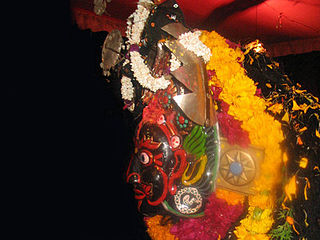
Bhairab Pyankhan. "Bhairava's Dance" is an ancient masked dance performed by Newar community in the Pokhara Valley of Nepal as part of the Bhairab Jatra festival and named after Bhairab Bhairava, an aspect of Shiva.
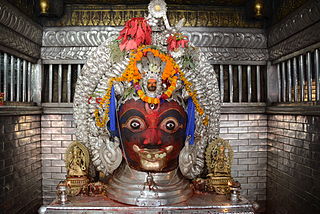
Akash Bhairav or Aaju is one of the different forms of Bhairava.

Madhyapur Thimi, also known as Thimi, is a municipality in Bhaktapur District in the Bagmati Zone of central Nepal. Thimi lies between Kathmandu, Lalitpur and Bhaktapur in the Kathmandu Valley. It is one of the ancient cultural and historical places along the trade route from Bhaktapur to Kathmandu. The city is situated on elevated land and occupies an area of 11.47 square kilometres (4.43 sq mi), divided into nine administrative wards.

Naagdesh (Nagadesh) is an ancient Newar city in Madhyapur Thimi Municipality in Bhaktapur District in the Bagmati Zone of central Nepal. In 2011 it had a population of approximately 6,900 with more than 1500 houses in it, according to the 2011 Nepal census. At the time of the 1991 Nepal census it had a population of 4,237 with 693 houses in it. Most people are engaged in farming.
Tokha Chandeshwari is a village and former Village Development Committee that is now part of Tokha Municipality in Kathmandu District in Province No. 3 of central Nepal. At the time of the 2011 Nepal census it had a population of 3,961. Tokha Chandeshwari now is part of Tokha municipality.
Bungamati, is a settlement in Lalitpur Metropolitan Region, Ward No. 22 in Lalitpur District, Nepal. Bungamati is a Newar town on a spur of land overlooking the Bagmati River

Indra Jātrā, also known as Yenyā, is the biggest religious street festival in Kathmandu, Nepal. The celebrations consist of two events, Indra Jātrā and Kumāri Jātrā. Indra Jātrā is marked by masked dances of deities and demons, displays of sacred images and tableaus in honor of the deity Indra, the king of heaven. Kumāri Jātrā is the chariot procession of the living goddess Kumari.

Pratap Malla was a Malla king and the eighth King of Kantipur from 1641 until his death in 1674. He attempted to unify Kathmandu Valley by conquering Lalitpur and Bhaktapur, but failed in the effort. He was successful in extending and securing the borders of Kantipur and was responsible for the monopoly over trade with Tibet. The resulting prosperity was responsible for the construction of majority of the buildings around Durbar Square during his reign. His reign is seen as a cultural and economical high point of the Malla dynasty.
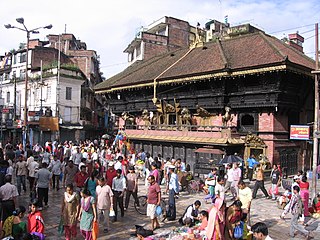
Indra Chowk or Wongha: (Newari) is one of the ceremonial and market squares on the artery passing through the historic section of Kathmandu, Nepal. The intersection of Indra Chowk, along with Maru, Kathmandu Durbar Square, Makhan, Jana Baha, Asan and Naxal, mark the old India-Tibet trade route that is now a vibrant market street.
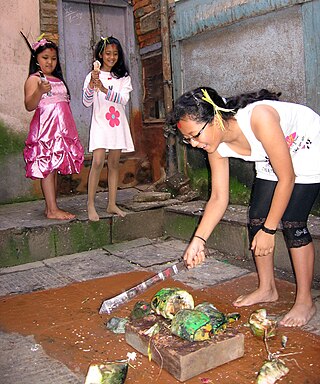
Mohani or Mohni is one of the most important festivals among the Newars which involves a packed itinerary of religious services, pilgrimages, family gatherings and outdoor celebrations lasting several days. Special dinners known as Nakhtya, to which all the relatives are invited, continue for weeks later. Mohani is the equivalent of Nepal's biggest festival Dasain, and there are similarities and differences between the two.

Shreekhandapur is a city situated in the Dhulikhel municipality in Kavrepalanchowk district in Nepal.This historical town is about 28 km east from Kathmandu. The city is located roughly at 1400m above sea level. The main attraction of Shreekhandapur is the temple of Swet Bhairav, located approximately 1 km northeast of the town. The name Shreekhandapur was originally given due to the presence of the tree Shreekhand. Its name during the Licchavi period was खम्पू which is still used predominantly by the Newar community living in this town.
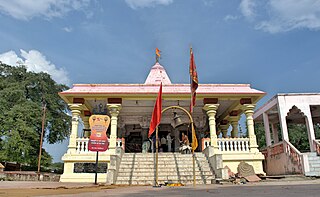
The Kal Bhairav temple is a Hindu temple located in the Ujjain city of Madhya Pradesh, India. It is dedicated to Kal Bhairav, the guardian deity of the city. Located on the banks of the Shipra River, it is one of the most active temples in the city, visited by hundreds of devotees daily. Liquor is one of the offerings made to the temple deity.

Siddhikali Temple is a Hindu temple located in Thimi, Nepal. The two storeys roofed temple is dedicated to Lord Kali, Shiva and Ganesh. It is also believed that this Shaktipeeth is formed due to the falling of right eye of the corpse of Sati. This place is located in Inayekwo, in the north west of Thimi. The temple is also known as Inayekwo Dyo in Nepal Bhasa language. And Siddhikali Temple is also known as Chamunda, one of the goddess of Astamatrika. The majestically impressive Siddhikali temple has numbers of Pataa streaming down the front. There's a Satah (rest-house) opposite to temple and multiple Falcha (Inns) and several smaller shrines to the rear and nearby and several stone taps around the place. The artwork around the Siddhikali temple is fantastic and worth a close inspection.
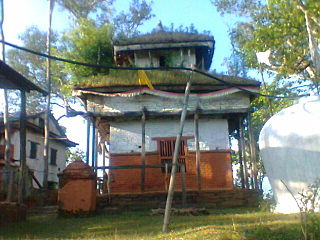
Dhuleshwor is a religious site in Dailekh District in Karnali Province, Nepal. It is one of five places under the Panchkoshi, the five holy places of Dailekh. This site is located at Badalamji village of Dullu Municipality.

Dance is a performing art form consisting of purposefully selected sequences of human movement. Dance (Nepali: नृत्य/ नाच) in Nepal comprises numerous styles of dances, including folk, ethnic, classical to modern dances. Lakhey is the dance of a demon in the carnival of God. Durbar Square, a historic plaza in Kathmandu, Nepal, facing ancient palaces and adorned by Hindu temples, is always full of eager crowds on the last day of Indra Jatra, the festival celebrating Indra, the Hindu king of heaven. In this divine stage, Lakhe the demon dances among gods and deities relentlessly and carelessly.
Bhairabkunda Shiva Mandir or Daifam Shiv Mandir is one of the most important Hindu temples in Bhutan. It is the only Shakti Peetha in Bhutan. It is located in the south east corner of Bhutan near the town of Jomotsangkha (Daifam) and it shares border with the Indian states of Arunachal Pradesh to East and Assam to the South. It is located 24 km from the Indian town of Udalguri in Assam.

Bagh Bhairab Temple(Nepali: बाघ भैरव) is a historic Hindu temple dedicated to Bagh Bhairab, an incarnation of Shiva as a tiger. It is located in Kirtipur, Bagmati Province, Nepal and dates back to the 16th century. The residents of Kiritpur believe that Bagh Bhairab protects the town. Bagh Bhairab Temple features the swords used by King of Gorkha Prithvi Narayan Shah's army during the Battle of Kirtipur.
Indrayani Jatra is an annual celebration done at Kathmandu, Nepal. The festival is held for eight days every year, starting on Marga Krishna Ekadashi. The festival is celebrated by both Buddhist and Hindu communities together. The origin of the Jatra is unknown, but is believed to be started by the Licchavi.















